 Abengoa
Abengoa
Annual Report 2012
- Activities
- Activities
- Industrial production
- Solar power
Since its inception, Abengoa´s solar business has acquired a wealth of experience along the different stages of the value chain within the solar thermal business and, by extension, within the industrial production segment.
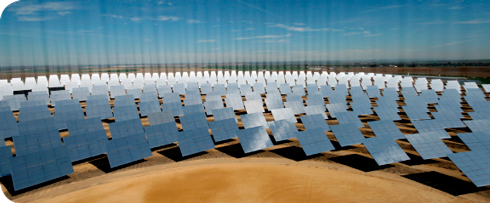
Abengoa market leadership should enable us to offer the most competitive prices for solar power generation via our projects, while helping us to monetize investments in R&D+i by harnessing the growth of third-party businesses.
Abengoa´s solar business focuses its industrial production activity on:
- Marketing and supplying key components for our plants and third-party facilities. This is the case, for example, with our parabolic troughs, our troughs for industrial applications, our mirrors for parabolic trough and power tower plants, and our modules and systems for high concentration photovoltaic applications.
- Designing new solar thermal and photovoltaic components and technologies and defining future marketing strategies.
- Developing and honing operation and maintenance equipment.
Developing new technologies and components, which can be applied to the company’s own plants and also sold to third parties, is one of the segments in which Abengoa´s solar business is basing the future growth of the business.
Thanks to its status as the world’s leading company in terms of concentrating solar power in operation, Abengoa has built up a wealth of knowledge in plant operation and maintenance, enabling it to make groundbreaking improvements to plant design and operating methods. These advances, coupled with its heavy commitment to R&D+i, have made Abengoa a unique company capable of offering new tried and tested technological components that are highly efficient and competitive. The company is also able to generate added value by selling its “expert knowledge” on to third parties.
Significant milestones in industrial production for 2012 included:
- E2. New generation of parabolic trough structure.
During 2012, Abengoa developed a new generation of parabolic trough, called E2.2, a major advance on the first generation of E2, which was in turn preceded by the ASTRO trough. This new generation features design improvements that allow for a more efficient installation and improved operational performance.
The E2 trough is made up of between ten and twelve modules measuring twelve meters in length with approximately six meters of aperture area. The structure comprises tubular steel bars arranged into triangles, enabling it to resist the force generated by the wind blowing against the mirrors. This new design allows the force applied from the weight of the trough to pass through the structure’s center of gravity, meaning that no internal torque is generated other than that produced by normal wind action. - ASUP 140. Development of a new generation of heliostat.
As a result of the ongoing drive to lower power generating costs, 2012 saw Abengoa unveil the new ASUP 140 heliostat. This model, based on the SL120 heliostat, offers a series of innovative features that combine to lower the costs of a solar field by approximately 30 %. In addition to these cost savings, the new design provides complete protection against rust and wear and improved mechanical resistance. Moreover, the hydraulic tracking system provides unrivalled precision and reliability, coupled with average annual availability of over 99 %. The new heliostat has been designed to use a new concept of facet, which combines a 2 mm sheet of glass with a foam support. The result is a solar field with reflectivity levels of over 95 %. The ASUP 140 has been validated through an exhaustive process that included wind tunnel testing, structural and optical trials and prototype field operation at the Solúcar Solar Platform. The new heliostat will be installed commercially at the Khi Solar 1 plant, our first 50 MW facility to employ superheated steam power tower technology in South Africa.
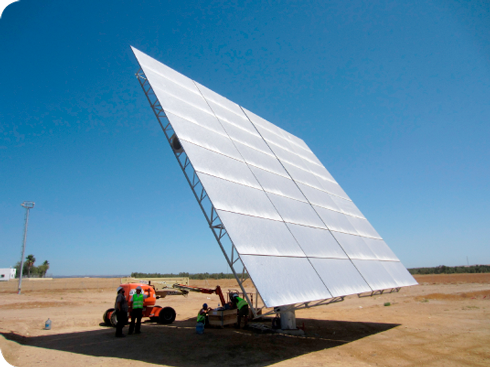
- Condor. New portable reflectometer for solar field characterization.
The Condor is a groundbreaking device developed by Abengoa to measure reflectivity, offering operators a highly reliable means of characterizing reflectivity at solar fields. Covering six different wave lengths, the Condor is able to characterize all the states that a mirror can experience at a solar thermal power plant, while offering similar levels of precision along the entire reflectancy range. The Condor also offers excellent outdoor performance under very hot conditions with high levels of solar irradiation. Reliable and proper solar field characterization can help optimize cleaning work and, therefore, increase the plant’s power generation.
The company sold more than twenty Condor devices in 2012 and also staged a number of training sessions on how to use the equipment at the different solar platforms.
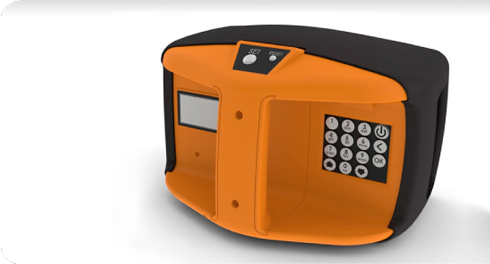
- Cleaning truck.
Abengoa and a specialist partner have continued to hone the design of the parabolic trough mirror cleaning vehicle. The truck has helped to streamline solar field maintenance work, while also shortening working shifts and reducing water consumption and the number of operators needed to carry out the maintenance work. This has brought about a marked increase in the performance of the solar field by reducing the resources needed to operate it.
The main features of the vehicle include two cleaning arms, each controllable independently and with a 180 º operating range, thus enabling the operators to clean the entire reflective surface. Over 2012, Abengoa worked through its industrial partner on selling the vehicle to both the company’s own plants and third-party plants, with over ten units supplied to different facilities.
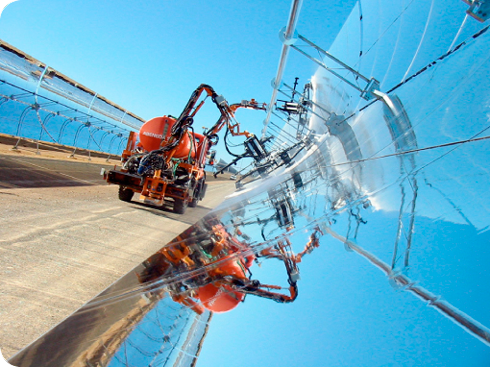
- High concentration photovoltaic technology (HCPV).
Abengoa has developed a new generation of high concentration photovoltaic technology that is proving enormously more efficient and much cheaper to install than its predecessor. This new photovoltaic technology offers a range of advantages, of which we would highlight:- The silicon has been replaced with a combination of semiconductors to increase cell efficiency by over 40 % and enhance cell performance under extreme climatic conditions.
- High associated efficiency of over 30 % per module.
Abengoa has already conducted tests confirming the efficiency of the technology by installing three pilot plants at Puertollano with a combined total of 300 kW, meaning the technology is now optimally positioned for a marketing drive over the coming years.
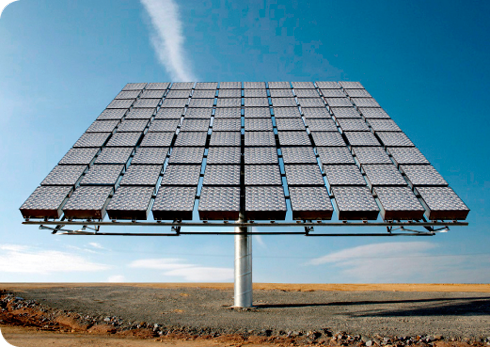
Included below are the key industrial production figures for 2012:
- The company supplied over 1,300,000 parabolic trough mirrors over the course of 2012, both within Spain -to plants operating at the Extremadura Solar Platform- and abroad -to the Solana and Mojave plants currently under construction in the United States, and to the Aguas Prietas facility in Mexico, as well as to other companies such as Lanco and Abhijeet in India.
- The company supplied more than 2,000 parabolic troughs of the different models currently on sale, including ASTRO and E2, to the plants operating at the Extremadura Solar Platform, to Aguas Prietas in Mexico, and to the Solana and Mojave plants in the United States.

The company supplied facilities in Chile, Brazil, Canada and the United States with parabolic troughs for industrial applications, totaling over 10 MW. Abengoa Solar, with the collaboration of Abengoa Chile, has designed, engineered and supplied parabolic troughs for the world’s largest industrial solar steam complex and the first commercial solar thermal facility in Latin America. The plant is located in Antofagasta, Chile, and has a thermal capacity of 10 MW. Abengoa has also supplied troughs for a hot water installation on the premises of Kraft Foods in Brazil; for a small demonstration plant at Red River College of Applied Arts, Science and Technology in Winnipeg, Canada, with the plant up and running since July; and for two small 40 kW facilities at the premises of Cummins Power Generation in both Fridley and Shoreview, Minnesota.
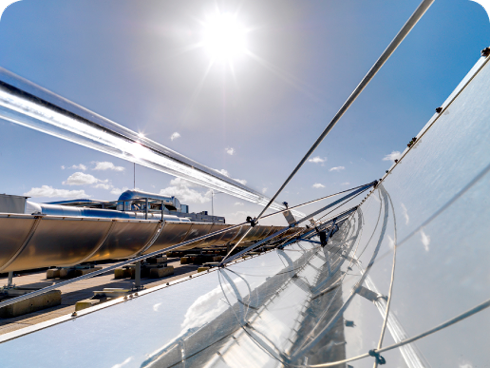
Turning our attention to operation and maintenance equipment, Abengoa supplied roughly 20 Condor reflectometers to different plants within Spain and abroad, while also carrying out a technology transfer to the Spanish National Center for Renewable Energies (CENER) and another to the National Renewable Energy Laboratory (NREL) in the United States. Ten mirror cleaning vehicles were also sold to various parabolic trough plants.
In addition, Abengoa supplied the final four trackers to complete the installation of sixteen high concentration photovoltaic trackers at the Spanish Institute for Concentration Photovoltaics Systems (ISFOC), while also supplying trackers for pilot plants in Asia, the Middle East and South America.
Our progress made with proprietary technology has also enabled us to continue cutting generation costs and to monetize our investments in R&D+i through technology transfers to third parties for the construction of solar power plants. We are confident that this line of business will continue to generate significant revenue for the company over the coming years on the back of our proactive management of our technologies portfolio, which already features a number of new developments, coupled with a solid industrial protection strategy.
Last but not least, the company has reached a total of 743 MW in operation, a figure that will continue to grow over 2013 following the operational start-up of some of the 910 MW currently under construction. For this reason, streamlining the operation and maintenance of our plants is key to the success of the solar power business.
Since 2007, when our first commercial plant, PS10, was commissioned, and thanks to the steady start-up over the years of new solar power plants, embracing both power tower and parabolic trough technologies, we have been able to gradually optimize both plant start-up and operation and maintenance, responding well to what has become a very demanding process. Abengoa has implemented a standardized plant operation monitoring system, allowing us to track changes in key plant operating figures and carry out benchmarking. The company has also been harnessing synergies, enabling us to group plants together at solar platforms, or as part of largescale international complexes. With the goal being continuous improvement and to learn from past experiences, Abengoa has rolled out training programs in O&M and on how to capitalize experience so that our operators can tackle the operation and maintenance of new plants with greater likelihood of success.
Abengoa will remain committed to innovation in 2013, specifically in those technologies flagged as key, with a view to keeping ahead of its competitors, while also lowering costs and making its technologies more efficient. It also intends to channel much of its resources into expanding its portfolio of components by seeking out new technological partners and strategic alliances with leading companies and institutions, shaping marketing strategies for its current portfolio of technologies and in development, and securing protection for its intellectual property, thus helping to ensure the ongoing technological and commercial leadership of Abengoa.
PS20 heliostat field
ASUP 140 heliostat
Condor reflectometer
Parabolic trough cleaning truck
New generation HCPV tracker
E2 trough in place at the Solana solar field
Industrial parabolic trough
© 2012 Abengoa. All rights reserved
